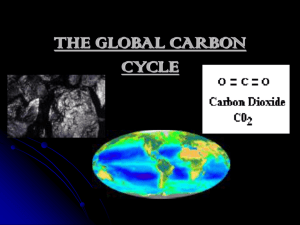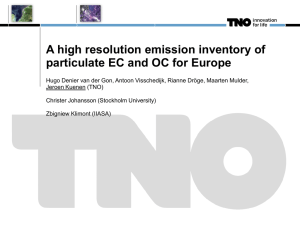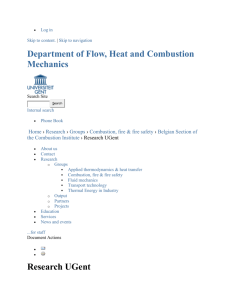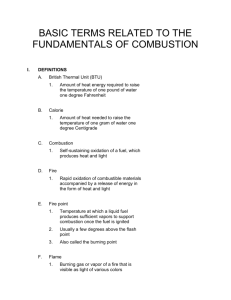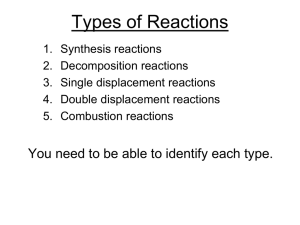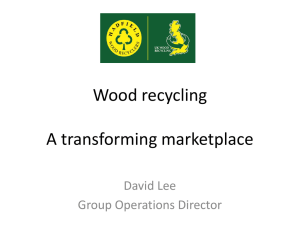Firing installations for wood and other biomass fuels
advertisement
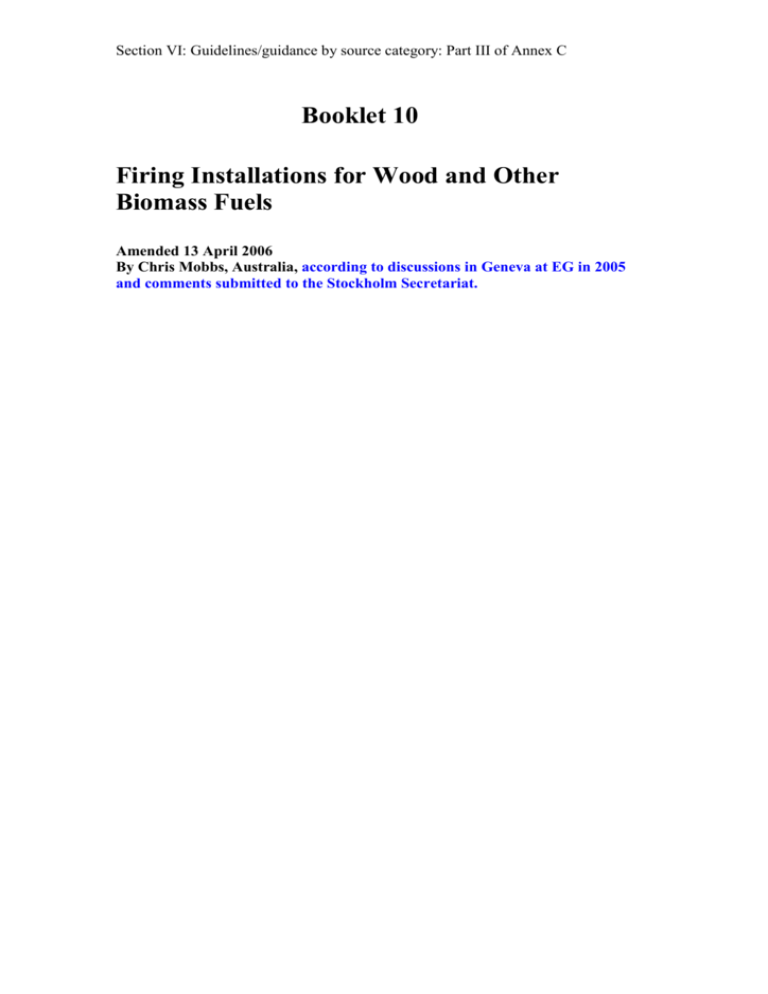
Section VI: Guidelines/guidance by source category: Part III of Annex C Booklet 10 Firing Installations for Wood and Other Biomass Fuels Amended 13 April 2006 By Chris Mobbs, Australia, according to discussions in Geneva at EG in 2005 and comments submitted to the Stockholm Secretariat. Section VI: Guidelines/guidance by source category: Part III of Annex C Table of Contents Firing installations for wood and other biomass fuels ................................................... 3 1 Introduction ........................................................................................................ 3 2 Biomass combustion technologies ..................................................................... 4 2.1 Technology selection and furnace types .................................................... 4 2.2 Grate furnaces ............................................................................................ 6 2.3 Fluidized bed combustion .......................................................................... 7 2.4 Further combustion technologies for wood ............................................... 7 2.5 Energy conversion techniques ................................................................... 8 2.6 Co-combustion ........................................................................................... 8 2.7 Wood gasification ...................................................................................... 9 2.8 Combustion of other biomass .................................................................... 9 2.9 Recovery boilers in the pulp and paper industry ....................................... 9 2.10 Combustion of peat .................................................................................. 10 3 Emission control measures .............................................................................. 10 3.1 Relevant primary and secondary measures .............................................. 10 3.2 Fuel characteristics................................................................................... 11 4 Process outputs................................................................................................. 12 4.1 Formation of PCDD and PCDF in combustion processes ....................... 12 4.2 Emissions of PCDD/PCDF ...................................................................... 12 5 Best available techniques and best environmental practices ........................... 14 5.1 Primary measures and process optimization to reduce PCDD/PCDF emissions .............................................................................................................. 14 5.2 Secondary measures ................................................................................. 15 6 Achievable performance and emission levels .................................................. 15 7 Performance monitoring and reporting ............................................................ 15 References ............................................................................................................ 16 Section VI: Guidelines/guidance by source category: Part III of Annex C Firing installations for wood and other biomass fuels Summary The main purpose of firing installations for wood and other biomass fuels is energy conversion. Large-scale installations for firing wood and other biomass fuels mainly use fluidized bed combustion and grate furnaces. Technologies for small-scale plants include underfeed furnaces and cyclone suspension furnaces. Recovery boilers in the pulp and paper industry apply specific combustion conditions. Technology selection is related to fuel properties and required thermal capacity. Chemicals listed in Annex C of the Stockholm Convention can result from the firing of wood and other biomass fuels, particularly in the case of fuel contamination. Best available techniques and best environmental practices to achieve performance levels for chemicals listed in Annex C of below 0.1 ng TEQ/Nm3 employ a combination of primary and secondary measures. Among the primary measures, control of fuel quality is a key issue (including exclusion of treated wood). Control measures for non-contaminated biomass include optimized combustion techniques and dust removal. Combustion of contaminated biomass, such as wood waste, requires additional measures, such as sorbent injection. Also solid waste from biomass combustion should be dealt with in this section (coarse ash, fly ash). It should be included here, that fly ash (esp. the finest fraction) from biomass combustion has to be landfilled due to it s high heavy metal content. Also POP content can be high. It should also be mentioned here, that in many countries (and in the EU), wood treated with chlorinated compounds or heavy metals is regarded as waste and falls under the scope of the waste incineration directive (in this case a reference should be made to the waste incineration section). Other environmental benefits that accrue from applying best available techniques and best environmental practices include resource conservation and avoidance of carbon dioxide emissions originating from fossil fuels (in the case of substitution). 1 Introduction At present around 12% of the global energy requirement is generated by combustion of biomass fuels, which vary from wood and wood waste (for example, from construction or demolition) to crops and black liquor. Table 1 shows the types of material used. A wide variety of appliances are used to convert this biomass into useful energy. In developing countries, around 35% of the energy used originates from biomass, but most of this is for noncommercial use in traditional applications such as cooking (see section VI.C of the guidelines). In a country such as Nepal, over 90% of the primary energy is produced from traditional biomass fuels. Please include a sentence to differentiate between untreated biomass and biomass which is regarded as waste (due to its content of POPs or heavy metals). In relevant laws (e.g. EU waste incineration directive, EU Large combustion plant directive) a clear differentiation is made. My suggestion is to concentrate only on wood and wood related biomass such as straw, husks and bagasse, but to leave biomass waste (such as treated wood, sewage sludge, leather and others) outside of the scope of this section. Also incineration of black liquor in recovery boilers and of primary sludges in fluidised bed boilers of the pulp and paper industry should not be dealt with in this section. Section VI: Guidelines/guidance by source category: Part III of Annex C Table 1. Types of biomass fuels used Wood – dust, chips, pellets, demolition waste Timber and logs Straw Coconut husks Coffee seed husks Rice husks Peat moss Sugar cane bagasse Animal dung Other suggestions ??? Biomass regarded as waste: demolition wood, etc Others ?? In industrialized countries, the total contribution of biomass to the primary energy mix is only 3% but this amount is expected to increase as more countries use biomass fuels to reduce greenhouse gas emissions instead of burning fossil fuels. This mainly involves the combustion of commercial biomass fuels in modern devices (for example, woodchip-fired cogeneration plants for heat and power). Other applications are domestic space heating and cooking, industrial heat supply, and large-scale power generation in coal-fired plants (IEA Bioenergy 2004). 2 In the present section only large-scale applications in, for example, industry, power generation and district heating are covered (including combustion of peat – However it should be mentioned in a footnote, that peat is regarded as fossil fuel within the EU emission trading system).Biomass combustion technologies 2.1 Technology selection and furnace types For technology selection the total heat input and the wood fuel quantity are of major importance. For large-scale plants, fluidized bed combustion and grate furnaces are most suitable. Technologies for small-scale plants include underfeed furnaces and cyclone suspension furnaces. Table 2 shows typical thermal capacities and required fuel properties for different types of wood combustion techniques. Table 2. Types of biomass furnaces with typical applications and fuels Application Manual Pellets Type Typical size rangea Fuels Ash Water content Wood stoves 2 kW–10 kW Dry wood logs < 2% 5–20% Log wood boilers 5 kW–50 kW Log wood, sticky < 2% wood residues 5–30% Pellet stoves and boilers 2 kW–25 kW Wood pellets 8–10% < 2% Section VI: Guidelines/guidance by source category: Part III of Annex C Application Type Automatic Understoker furnaces Co-firingb Typical size rangea Fuels Ash Water content 20 kW–2.5 MW Woodchips, wood < 2% residues 5–50% Moving grate furnaces 150 kW–15 MW All wood fuels < and most biomass 50%??? 5–60% Pre-oven with grate 20 kW–1.5 MW Dry wood (residues) 5–35% Understoker with rotating grate 2 MW–5 MW Woodchips, high water content < 40–65% 50%???? Cigar burner 3 MW–5 MW Straw bales < 5% 20% Whole bale furnaces 3 MW–5 MW Whole bales < 5% 20% < 5% Straw furnaces 100 kW–5 MW Straw bales with bale cutter < 5% 20% Stationary fluidized bed 5 MW–15 MW Various biomass d < 10 mm < 50% 5–60% Circulating fluidized bed 15 MW–100 MW Various biomass d < 10 mm < 50% 5–60% Dust combustor, entrained flow 5 MW–10 MW Various biomass d < 5 mm < 5% < 20% Stationary fluidized bed Total 50 MW–150 MW Various biomass d < 10 mm < 50%??? 5–60% Circulating fluidized bed Total Various biomass 100 MW–300 d < 10 mm MW < 50%??? 5–60% Cigar burner Straw 5 MW–20 MW Straw bales < 5% 20% Dust combustor in coal boilers Total 100 MW–1 GW Various biomass d < 2–5 mm < 5% < 20% a. kW = kilowatt; MW = megawatt; GW = gigawatt. b. Biomass covers typically less than 10% of the total fuel input. Source: Nussbaumer 2003. Section VI: Guidelines/guidance by source category: Part III of Annex C Typical biomass based on wood has a ash content below 5 %; higher ash contents can be attributed to other biomass such as sewage sludge; the ash content is an important issue due to concentration of pollutants 2.2 Grate furnaces Grate furnace systems are today the most common combustion technology used for wood wastes and wood residues. According to the technique, the wood fuel is moved through the combustion chamber using stationary sloping grates, travelling grates, vibrating grates (Figure 1) or moving grates. Grate firing systems are suitable for all types of wood residues and wood waste with particle sizes between 20 and 300 mm. However, fine particles, as pulverized wood, may be injected through additional burner lances. A major influence on the combustion efficiency, both for travelling grates and vibrating grates, is the fuel and air guidance. As regards steam generation, the furnace design of grate firing systems offers various options for primary emission reduction, including staged combustion and flue gas recirculation. The investment for grate firing systems depends considerably on the grate technology and flue gas cleaning technology used. Compared to fluidized bed combustion plants, especially for lower capacities, the specific investment relative to the total heat input is considerably lower (CSTB 2000). Section VI: Guidelines/guidance by source category: Part III of Annex C Figure 1. General scheme of a vibrating grate furnace Boiler Wood fuel input Tertiary air duct (optional) Secondary air duct Economizer Waste gas duct to gas cleaning Drying zone Combustion zone Ash conveyor 2.3 Ash container Fluidized bed combustion Fluidized bed combustion is utilized for various types of solid fuels. In a typical fluidized bed combustion unit, the solid fuel is kept fluidized by injected air together with an inert bed material mainly consisting of limestone or sand and the fuel ash. Two basic fluidized bed combustion technologies are primarily used for wood combustion. These are atmospheric bubbling fluidized bed combustion and atmospheric circulating fluidized bed combustion (Figure 2). Fluidized bed combustion is suitable for even lowest fuel qualities and for a great variety of fuels. For wood combustion, nearly all types of wood residues and wood waste can be used. Water contents up to 60% are possible. Fluidized bed systems are adaptable even to low operation loads. A cycle between low and high loads is generally possible without support fuel and at a higher speed than other combustion technologies. Chlorine-induced high-temperature corrosion can be suppressed by installing the last superheater unit in the bed. The low combustion temperature in fluidized bed systems, compared to many other combustion technologies, offers several operational advantages for emission control. The investment for fluidized bed combustion plants is mainly influenced by the technology used and the type of flue gas cleaning installed. Circulating fluidized bed combustion entails a considerably higher specific investment than bubbling fluidized bed combustion for plant sizes below 30 MW(CSTB 2000). 2.4 Further combustion technologies for wood Further combustion technologies for wood include underfeed stoker furnaces, cyclone suspension furnaces (muffle suspension furnaces), rotary furnaces, turbulent bottom furnaces, fan blower furnaces and dust burners. Underfeed furnaces or underfeed stoker furnaces are particularly suitable for the combustion of dry and not too coarse wood particles with a low ash content. This technique is used for total heat inputs up to 5 MW. Compared to normal grate furnaces the specific investment is generally lower. As cyclone suspension furnaces require a dust content of at least 50% their application is limited mainly to the wood processing industry. Dust burners are used for wood dust with a particle size of up to 1 mm. Applications of this burner type include woodchip dryers and the injection of wood dust in cement furnaces (CSTB 2000). Section VI: Guidelines/guidance by source category: Part III of Annex C Figure 2. General scheme of furnace using circulating fluidized bed combustion Stack Steam generation Cyclone Steam generation Fluidised bed boiler Air preheater Electrostatic precipitator Secondary air Ash Wood fuel and bed material Steam generation Air Primary air Bed cooler Air 2.5 Energy conversion techniques For energy conversion downstream of wood combustion furnaces, heat exchanger systems (boilers) and subsequent systems for combined heat and power production (for example, steam turbines, steam engines) have to be distinguished. The type of boiler used depends on the heat transfer medium, the plant size and the energy quality required. Firetube boilers are used for hot water or steam production downstream of small-scale and medium-scale wood furnaces. Heat transfer only takes place by convection. Watertube boilers are used for largescale and medium-scale wood waste combustion plants. The water to be evaporated flows through tubes surrounded by the hot flue gases. Heat transfer takes place predominantly by radiation. Compared to firetube boilers, considerably higher operating pressures are possible – up to 100 bar. Downstream of wood furnaces only heat or combined heat and power are generally produced. For this reason condensing power generation can be neglected. Nevertheless, combined heat and power plants may also need condensing capacities in case the heat generated is not used (CSTB 2000). 2.6 Co-combustion of (untreated) wood and wood related biomass Co-combustion means the burning of wood wastes and wood residues together with other waste materials or together with fossil fuels. The objective is to realize synergy effects between two combustion processes. Benefits include savings in operating costs through the use of cheaper secondary fuels, and the greater combustion efficiency of the combined process compared to the two processes operated separately. For wood waste and wood residues, relevant practices include co-combustion in cement furnaces, co-combustion in coalfired power plants, co-gasification with fossil fuels and waste and co-incineration in waste incineration plants (CSTB 2000). For further information see sections V.A, V.B, and VI.D of the guidelines. Section VI: Guidelines/guidance by source category: Part III of Annex C 2.7 Wood gasification Gasification of wood and wood waste is the conversion of solid and liquid residues derived from the thermochemical decomposition of the organic matter in the wood at high temperatures in a gaseous fuel by adding oxidizing reactants. The main objective of wood gasification is to transfer as much as possible of the chemical energy of the wood feedstock into a gaseous fraction (producer gas) consisting mainly of combustible gaseous products with a low molecular weight. The gasification techniques available are in general related to the reactor type. The two basic gasification techniques available are fixed bed gasification and fluidized bed gasification. For wood gasification the utilization of fixed bed gasifiers is in general preferred for smaller total heat inputs below 5 MW. For larger capacities fluidized bed gasifiers are mainly used. The energy content of the producer gas from gasification can be used either thermally for the firing of a boiler or for another thermal process (either separately or using co-combustion, for example in an existing utility boiler or in a cement furnace) or mechanically for power generation in gas engines or gas turbines. Further possibilities are the utilization of the producer gas for methanol synthesis or in fuel cells. The system needed for producer gas cleaning is determined by the concentration of impurities and by the requirements of the gas utilization technique used. Depending on the gas utilization technique, gas cleaning is required to avoid erosion, corrosion and unwanted deposits, and to ensure fulfilment of emission limits. Two different gas cleaning concepts, cold (or wet) gas cleaning and hot gas cleaning, can be distinguished. Hot gas cleaning is considered advantageous for advanced highly efficient systems due to the higher achievable electric and overall efficiencies and due to the non-generation of contaminated waste water or condensate. Even though gasification can be seen as a proven and reliable technique, for all plants with electricity generation, either in gas turbines or gas motors, gas cleaning is still a crucial restriction. Problems associated with the gas cleaning process include process control, the cost of gasification residue disposal, and the high investment and operating costs of the gas cleaning unit itself (CSTB 2000). 2.8 Combustion of other biomass Other biomass fuels include other solid biofuels, such as straw and crops, and liquid fuels, such as canola oil. Straw combustion requires combustion techniques that are not sensitive to the slagging of ashes. Due to the greater input of mineral matter and chlorine compared to wood combustion, there is an increase in emissions of dust, hydrogen chloride (HCl), polychlorinated dibenzo-p-dioxins (PCDD) and polychlorinated dibenzofurans (PCDF) (LfU 2002). Exemplary results from emission tests are given in subsection 4 below. Problems arising with straw combustion (e.g. fouling of surfaces and comparable high emissions of POPs should be mentioned in a more prominent position and also in the summary. 2.9 Recovery boilers in the pulp and paper industry The manufacture of pulp utilizes mechanical, thermomechanical, chemi-mechanical and chemical methods (see section V.C of the guidelines). In chemical pulping, the fibres are broken down chemically. Chemicals are used in a cooking process to enter the fibre lumen and dissolve lignin in the cell walls to gain access to the compound middle lamella. Lignin has to be removed from the lamella to free the fibres. The lignin and many other organic substances are thus put into solution. The chemicals used in sulphate (Kraft) and sulphite pulping are recovered from this solution through combustion in boilers, which also allows for energy recovery. Recovery boilers in sulphate (Kraft) pulping operate in a first step under reducing conditions, leading to the formation of sodium sulphide. A molten residue consists of sodium sulphide and sodium carbonate. In the second and third steps of the combustion process, a staged Section VI: Guidelines/guidance by source category: Part III of Annex C supply of combustion air occurs in order to assure complete burnout. Here, collected odorous gases can be supplied. Recovery boilers in sulphite pulping do not operate with staged combustion. The lye is burnt in oxidizing conditions with a low air excess. 2.10 Combustion of peat Within the European Union, peat is a significant fuel (but regarded as fossil fuel!!) in Ireland and Finland. Combustion technologies for peat are similar to coal combustion (section VI.D of the present guidelines). Today, peat is mainly burned in fluidized bed boilers (bubbling and circulating fluidized bed combustion). These boilers typically have a fuel input of less than 200 MW, and they produce both electricity and heat to local industry or the district heating system. Peat-fired boilers are usually also designed to combust other low-calorific fuels and sometimes coal. Heavy oil is commonly used as an auxiliary start-up fuel. Due to its characteristics peat is applicable for co-firing with wood. Technically it would be more difficult to use only wood fuel in existing plants because of corrosion and fouling problems. The ability to burn peat also assures continuous fuel supply in areas where the availability of wood is insufficient for the fuel demand (European Commission 2003). 3 Emission control measures 3.1 Relevant primary and secondary measures Reduction of PCDD/PCDF emissions includes the primary and secondary measures summarized in Table 3 (Baumbach and Zuberbühler 2002; CSTB 2000; LfU 2002). Relevant primary measures are similar to those used in the waste incineration sector. In the case of untreated biomass, secondary measures are restricted to dust abatement. Smaller furnaces may use multicyclones to achieve dust concentrations in the cleaned flue gas of 100– 150 mg/Nm3. Fabric filters or electrostatic precipitators achieve dust concentrations in the range of < 5 to 25 mg/Nm3 (see section III.C (iii) of the present guidelines for general guidance on flue gas cleaning). Downstream of wood waste combustion, additional flue gas cleaning can be carried out with absorption or adsorption processes. Generally only adsorption processes are used, due to their lower costs. Dry sorbent injection (entrained flow reactor) has gained major importance downstream of wood combustion due to its technical simplicity and its low costs. A mixture of calciferous substance and activated carbon or lignite activated carbon (activated carbon produced from lignite) is generally used as an adsorption agent. Possible calciferous agents are limestone (CaCO3), lime (CaO) and hydrated lime (Ca(OH)2). While the calciferous agents remove sulphur dioxide (SO2), hydrogen chloride (HCl) and hydrogen fluoride (HF), the various types of activated carbon minimize heavy metal emissions (mercury, cadmium and arsenic), PCDD/PCDF emissions and emissions of polycyclic aromatic hydrocarbons. A typical mixture used in an entrained flow reactor consists of 85–95% calciferous agent and 5– 15% activated carbon. As a secondary nitrogen oxides (NOx) emission reduction measure, particularly downstream of large-scale wood waste combustion installations, selective noncatalytic reduction can be used, but selective catalytic reduction may also apply. Table 3. PCDD/PCDF emission control measures for biomass firing installations Management options Emission level (%) Estimated costs Management risks Resulting emission Higher fuel price High water content increases Primary measures Control of fuel quality (e.g. Section VI: Guidelines/guidance by source category: Part III of Annex C Management options calorific value, water content, contaminants) Emission level (%) Estimated costs level not quantified Optimized burnout (e.g. reduction of excess air) Management risks PCDD/PCDF formation No additional cost for new installations Sufficient residence time of flue gases in the hot zone of the furnace Secondary measures Efficient dust abatement Medium efficiency Dry sorbent injection Selective catalytic reduction High efficiency Filter temperature < 200° C Additional investment:a selective catalytic reduction 110–180 % Disposal of used sorbents necessary, not common in combustion plants firing virgin biomass a. Percentage related to investment for furnace, boiler and dust collector of wood combustion plants with 1–10 MW thermal capacity. 3.2 Fuel characteristics (please make a clear differentiation between untreated biomass and biomass regarded as waste, see comments above) Fuel quality plays a major role in PCDD/PCDF formation during biomass combustion. PCDD/PCDF are always formed during wood combustion via precursors such as phenols and lignin, or via de novo reactions in the presence of particulate carbon and chlorine. High emission levels can be expected from burning treated wood (wood waste). Wood residues (waste and industrial) often contain various types of contaminants (chromated copper arsenate, pentachlorophenol, creosote, adhesives, resins, paint and other surface coatings). Another major source of PCDD can be salt-laden wood waste burnt in power boilers at pulp and paper mills (Lavric, Konnov and De Ruyck 2004). Combustion of contaminated wood, such as urban wood waste and demolition wood, should be strictly limited to installations with efficient emission control systems (such as waste incineration plants) (Nussbaumer 2003). remark: its not only the flue gas cleaning system, but emission control into all media (air, water, waste and soil) The moisture content of biomass can be high. Therefore, dryers may be used prior to combustion. Steam dryers are considered to be safe, with low environmental impact. Another method is based on drying with flue gas, which is subsequently fed to the stack. In this case emissions of organic compounds such as waxes or aromatic compounds are possible (European Commission 2003). Section VI: Guidelines/guidance by source category: Part III of Annex C 4 Process outputs 4.1 Formation of PCDD and PCDF in combustion processes The dominant reaction resulting in the formation of PCDD/PCDF in combustion processes is de novo synthesis. Section III.C (i) provides general information on PCDD/PCDF formation mechanisms. Specific considerations for biomass combustion are given below. PCDD can be formed in the absence of organic chlorinated compounds. The presence of particulate carbon and a chlorine source is sufficient. Investigations at a stationary grate combustor have shown that the total amount of PCDD/PCDF and coplanar polychlorinated biphenyls (PCB) formed was proportional to the chlorine content of the combustion samples when the temperature of the combustion chamber was lower than 700° C. On the other hand, when the grate temperature of the combustion chamber was higher than 800° C, there was only slight formation of PCDD/PCDF and coplanar PCB, regardless of the chlorine content of the fuel (Yasuhara, Katami and Shibamoto 2003). The better combustion conditions in larger facilities tend to have an influence on PCDD/PCDF concentration. Tests have shown that even when processing materials containing high halogen quantities, the concentrations remained below those obtained from small facilities using natural wood. When halogenated input materials were added, a very clear relationship between carbon monoxide (CO) and PCDD/PCDF concentrations was observed. The dominant influence of combustion quality on PCDD/PCDF emission concentrations could be seen from the increasing CO concentrations and simultaneously decreasing flue gas temperature (Lavric, Konnov and De Ruyck 2004). 4.2 Emissions of PCDD/PCDF 4.2.1 Combustion of wood or wood waste The influence of fuel quality and combustion conditions on PCDD/PCDF emissions is illustrated in Tables 4 and 5. Table 6 gives an overview of emission values observed for different types of wood fuel burnt in industrial furnaces. Table 4. PCDD/PCDF concentrations for different types of wood fuels Type of wood PCDD/PCDF min. ng I-TEQ/m³ (at 11% O2)a PCDD/PCDF max. ng I-TEQ/m³ (at 11% O2) Lump wood (natural) 0.02 0.13 Woodchips (natural) 0.004 0.88 Wood waste 0.03 18.00 Chlorine/heavy metal-free particle board 0.03 0.10 Particle board with PVC or ammonium chloride (NH4Cl) 0.05 12.28 Particle board with pentachlorophenol 0.21 5.14 a. 1 ng (nanogram) = 1 × 10-12 kilogram (1 × 10-9 gram). For information on toxicity measurement see section I.C, paragraph 3 of the present guidelines. Source: Nussbaumer 2004. Section VI: Guidelines/guidance by source category: Part III of Annex C Tests at an installation with ceramic filter and selective catalytic reduction showed significant PCDD formation in the filter at a temperature of 300 °C as well as the degree of PCDD destruction in the subsequent catalyst (Table 4). These tests show that wood waste can increase the emissions of the same installation by a factor of 20 compared to untreated wood (Nussbaumer 2004). Table 5. Test results for installation with ceramic filter and selective catalytic reduction Unit ( at 11% O2) Wood Particle board Waste wood PCDD/PCDF in raw gas ng TE/Nm3 0.083 0.095 17.76 PCDD/PCDF after filter ng TE/Nm3 0.836 2.947 78.25 PCDD/PCDF in clean gas ng TE/Nm3 0.052 0.189 8.18 Temperature ceramic filter °C 330 300 300 Temperature catalyst °C 240 230 230 A comprehensive review of PCDD/PCDF test results from wood-fired installations can be found in Lavric, Konnov and De Ruyck 2004. 4.2.2 Combustion of other biomass Launhardt and Thoma tested various herbaceous biofuels (straw, whole plant cereals and setaside hay) and spruce wood for their potential to form PCDD/PCDF, polychlorinated phenols, polychlorinated benzenes and polycyclic aromatic hydrocarbons during combustion. The trials were conducted in an automatically charged multifuel furnace for domestic applications of 50 kW. Relatively uniform combustion conditions were indicated by the CO emission results. Flue gas and different ash fractions were analysed. The concentration of PCDD was in the range of 0.052–0.891 ng I-TEQ/Nm3 at 13% O2 (Table 6). All the emissions from wood were at a relatively low level. Increased emissions, between 10 and 25 times higher, of PCDD/PCDF, polychlorinated phenols and polychlorinated benzenes were detected when herbaceous fuels were used (Lavric, Konnov and De Ruyck 2004). Table 6. PCDD/PCDF emissions from different types of biomass Fuel type PCDD/PCDF ng I-TEQ/m³ Wood (spruce) 0.052 Straw (wheat) 0.656 Hay 0.891 Triticale 0.052 Canola pellets 0.245 Source: LfU 2002. Section VI: Guidelines/guidance by source category: Part III of Annex C PCDD/PCDF emission data for liquid biomass combustion are scarce. Tests at a canola oil motor for combined heat and power production (90 kW) showed PCDD/PCDF concentrations of 4–7 pg TEQ/m3. PCB concentrations amounted to 40–81 ng/m3 (LfU 2002). 4.2.3 Combustion of black liquor Table 7 shows selected emission factors from Kraft black liquor recovery boilers. Table 7. PCDD/PCDF emissions from Kraft black liquor recovery boilers Fuel Black liquor solids Emission factor (I-TEQ) Emission factor (TEQ-WHO) Reference 0.10–0.15 ng/kg 0.10–0.16 ng/kg EPA 2000 0.029–0.065 ng/kg 0.028–0.072 ng/kg EPA 2000 0.07 ng/kg UNEP 2003 to assist readers I suggest adding a footnote: in general 1 kg black liquor (water content 70 %) corresponds to a flue gas volume of 5 – 8 m3 (oxygen content between 5 and 8 %) 4.2.4 Combustion of peat In European Commission BREF document 2003, PCDD emissions are reported from an atmospheric fluidized bed boiler equipped with a fabric filter firing 50% peat and 50% bark. PCDD/PCDF emissions amounted to 0.008 ng TEQ/Nm3 (dust emission level: 10 mg/Nm3). 4.2.5 Other releases of PCDD/PCDF from biomass combustion PCDD/PCDF are discharged with solid combustion residues such as bottom ashes and fly ash. In general, PCDD/PCDF concentrations increase with decreasing particle size (LfU 2002). Therefore, pollutant concentrations in fly ash tend to be higher than in bottom ash. Pohlandt and Marutzky analysed furnace, boiler and fly ash. The samples were collected at different plants in the wood working industry, from a smoke house and from combustion of wood impregnated with inorganic wood preservative consisting of boron, chromium and copper in a two-stage laboratory furnace. They found that the fly ashes exhibited the highest levels of PCDD/PCDF. The concentrations of PCDD/PCDF in the ashes originating from the impregnated wood were higher than those of the ashes from the combustion of the diluted impregnated wood, but below those determined for the fly ash of industrial wood firing plants. The concentration of PCDD in the fly ash was higher than in the bottom ash. This observation was confirmed by Wunderli et al. and Yamamura et al. (Lavric, Konnov and De Ruyck 2004). Particularly in the case of wood waste combustion, captured fly ash has to be disposed of in an environmentally sound manner. See section 111?? on fly ash disposal. The fly ash from straw combustion units is disposed of to landfill? , primarily due to its high content of cadmium. The bottom ash is normally brought back to the fields or used as a road construction material when certain requirements with regard to physical and chemical properties are met : please check if bottom ash from straw combustion can be used as a road construction material. I have some doubts about that. (European Commission 2003). It is important to mention, that especially the finest fraction of fly ash has to be sent to landfills due to its high content of heavy metals and POPs. Please also mention that used adsorbent have to be landfilled. 5 Best available techniques and best environmental practices 5.1 Primary measures and process optimization to reduce PCDD/PCDF emissions (Nussbaumer and Hasler 1998) Section VI: Guidelines/guidance by source category: Part III of Annex C 1. Prevention of illegal incineration of waste; 2. Combustion of contaminated wood, such as urban wood waste and demolition wood, should be strictly limited to installations with efficient emission control (i.e. air, water, solid waste from combustion); 3. Control of fuel quality (e.g. calorific value, water content, contaminants); 4. Optimized combustion technology: Improved burnout of gases and fly ash and reduction of dust content: Reduction of excess air ratio to < 1.5–2; Good mixing quality of gas and air (high turbulence); Sufficient residence time in the hot zone; Minimal disturbance of the glow bed and homogeneous distribution of the primary air; Optional integration of selective non-catalytic reduction for NOx reduction; 5. Measures in the boiler: Minimal residence time in the temperature range between 180° and 500 °C and minimal dust deposition ability; 6. Optimized plant operation: Application of advanced combustion control technologies to ensure optimal burnout in practice; Stationary operation, no on/off operation and prevention of rapid changes of heat and demand; Cleaning of the hot zone of flue gases at regular intervals. 6.2 Secondary measures 1. Optimized gas cleaning: Rapid quench of combustion gases (< 200° C) before passing through filters in order to avoid the de novo reformation (or synthesis) window; PCDD/PCDF separation in dust separators (electrostatic precipitators, fabric filters) in combination with sorbent injection (if necessary); 2. Optional destruction of PCDD/PCDF by catalytic oxidation, i.e., in combination with selective catalytic reduction for NOx reduction. 6 Achievable performance and emission levels For biomass-fired plants, particularly wood-fired installations, emission levels associated with BAT are below 0.1 ng I-TEQ/m3 . remark: achievable levels may be different from BAT associated emission levels. 7 Performance monitoring and reporting PCDD/PCDF emissions should be monitored in accordance with international standard methods. In order to ensure complete combustion, furnaces should be equipped with measuring instruments that continuously determine carbon monoxide emission mass concentrations. In order to ensure the performance of emission control equipment, furnaces should be equipped with measuring instruments that continuously determine dust emission mass Section VI: Guidelines/guidance by source category: Part III of Annex C concentrations qualitatively and quantitatively (according to the requirements of different plant sizes). In addition, quality control procedures should be implemented with regard to fuel composition. References Baumbach G. and Zuberbühler U. 2002. Entwicklung eines Feuerungskonzeptes zur Verbesserung des Ausbrandes bei gleichzeitiger NOx-Minderung bei der Holzverbrennung im gewerblichen Bereich. Report BWPLUS 3 96 007. Institut für Verfahrenstechnik und Dampfkesselwesen, University of Stuttgart. CSTB (Centre Scientifique et Technique du Bâtiment). 2000. Energy-Efficient Technologies from Demolition, Packaging and Industrial Wood Waste. Final Report. Programme THERMIE, Type B Action (STR-1965-98-FR), Phase I. CSTB with Quasco, CTBA, La Calade and DFIU/IFARE. EPA (United States Environmental Protection Agency). 2000. Exposure and Human Health Reassessment of 2,3,7,8-Tetrachlorodibenzo-p-dioxin (TCDD) and Related Compounds, Part I: Estimating Exposure to Dioxin-Like Compounds Vol. 2: Sources of Dioxin-Like Compounds in the United States. Draft Final Report. EPA, Washington, D.C. www.epa.gov/ncea/pdfs/dioxin/part1/volume2/volume2.pdf. European Commission. 2003. Reference Document on Best Available Techniques for Large Combustion Plants. Draft BAT Reference Document (BREF). European IPPC Bureau, Seville, Spain. IEA Bioenergy. 2004. Biomass Combustion and Co-firing: An Overview. IEA Bioenergy Task 32. www.ieabioenergy-task32.com . Lavric E.D., Konnov A.A. and De Ruyck J. 2004. “Dioxin Levels in Wood Combustion: A Review.” Biomass and Bioenergy 26:115–145. LfU (Bayerisches Landesamt für Umweltschutz). 2002. Energetische Nutzung nachwachsender Rohstoffe. Zusammenfassender Bericht zu 15 Teilprojekten. Nussbaumer T. and Hasler P. 1998. Emissions of PCDD/F from Biomass Combustion. Biomass for Energy and Industry, 10th European Conference and Technology Exhibition, 8– 11 June 1998, Würzburg (Germany). Nussbaumer T. 2003. “Combustion and Co-combustion of Biomass: Fundamentals, Technologies, and Primary Measures for Emission Reduction.” Energy and Fuels 17:1510– 1521. Nussbaumer T. 2004. Dioxin- und PAK-Emissionen der privaten Abfallverbrennung. Umwelt-Materialien Nr. 172. Bundesamt für Umwelt, Wald und Landschaft, Bern. UNEP (United Nations Environment Programme). 2003. Standardized Toolkit for Identification and Quantification of Dioxin and Furan Releases. UNEP, Geneva. www.pops.int/documents/guidance/Toolkit_2003.pdf. Yasuhara A., Katami T. and Shibamoto T. 2003. “Formation of PCDDs, PCDFs, and Coplanar PCBs from Incineration of Various Woods in the Presence of Chlorides.” Environ. Sci. Technol. 37:1563–1567. Section VI: Guidelines/guidance by source category: Part III of Annex C

